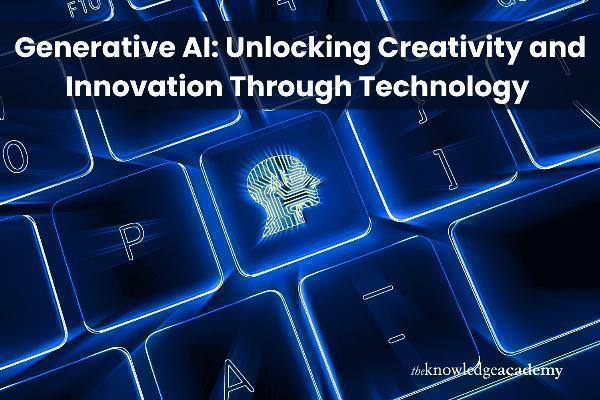Generative AI: Unlocking Creativity and Innovation Through Technology

Strong 8k brings an ultra-HD IPTV experience to your living room and your pocket.
Have you ever wondered how computers can generate entire works of art, compose music, or even write stories with human-like precision? The rapid evolution of Generative AI is transforming the way we approach creativity and problem-solving in industries across the board. Whether it is revolutionising content creation, enhancing product designs, or generating new business ideas, generative AI is becoming a powerful tool for individuals and businesses alike.
Curious about how to tap into its potential? A Generative AI Course could be your gateway to understanding this groundbreaking technology and learning how it is reshaping our world.
But what exactly is Generative AI, and how does it work?
Table of Content
- Understanding Generative AI
- How Does Generative AI Work?
- Real-World Applications of Generative AI
- Benefits and Challenges of Generative AI
- The Future of Generative AI
Understanding Generative AI
At its core, Generative AI refers to a type of artificial intelligence that is capable of creating new content. Unlike traditional AI systems that follow pre-defined rules, generative AI models can produce entirely original outputs based on the data they have been trained on. This can range from images and music to text and even video content.
Think of it as a computer system that learns patterns from vast amounts of data and uses those patterns to create something new. The most well-known example of generative AI is the GPT-3 model, which can generate human-like text in response to prompts. However, generative AI is not just limited to language; it encompasses a wide range of creative domains.
How Does Generative AI Work?
The magic of Generative AI lies in the algorithms known as neural networks, particularly Generative Adversarial Networks (GANs). GANs consist of two parts: a generator and a discriminator. Here’s how they work together:
The generator creates new data, for instance, an image that mimics a set of training images.
The discriminator evaluates this output to determine if it is authentic or generated. If the discriminator detects flaws, the generator learns and improves its output.
This cycle continues until the generator produces data that is almost indistinguishable from real-world data. The fascinating part is that generative AI models don't just copy existing data; they create new outputs by combining and modifying patterns.
Real-World Applications of Generative AI
The potential applications of Generative AI are vast, spanning across various industries. Here are just a few examples of where this technology is making a significant impact:
Content Creation: Whether it's writing blog posts, creating social media content, or designing graphics, generative AI tools like OpenAI’s GPT models are transforming how businesses approach content generation.
Product Design: Designers are leveraging AI to create prototypes and products with enhanced creativity. AI-generated designs can lead to innovative solutions that humans may not have thought of, offering companies a competitive edge.
Healthcare: In healthcare, generative AI is being used to create molecular structures for drug development, speeding up the process of discovering new treatments and improving patient care.
Entertainment: From generating realistic video game characters to composing music, generative AI is playing a role in transforming the entertainment industry.
Fashion and Art: AI-driven fashion designs and generative artwork are pushing the boundaries of creative expression, giving artists and designers new tools to explore their craft.
Benefits and Challenges of Generative AI
While the advantages of Generative AI are exciting, it comes with its own set of challenges. Let’s explore both sides:
Benefits:
Efficiency: AI can significantly reduce the time and effort required to create content or solve complex problems.
Innovation: By generating new ideas and designs, AI can inspire human creativity and lead to breakthroughs in various fields.
Personalisation: AI-driven content can be tailored to specific audiences, providing highly personalised user experiences.
Challenges:
Ethical Concerns: As AI systems become more autonomous, there are ethical concerns around the authenticity of AI-generated content and potential misuse.
Quality Control: While AI can generate content quickly, it may not always meet human standards of creativity or accuracy.
Data Dependency: Generative AI models require massive amounts of data to learn from, which can raise privacy and security issues.
The Future of Generative AI
The future of Generative AI is full of possibilities. As the technology continues to advance, we can expect even more sophisticated applications that go beyond mere content creation. AI may soon become a valuable partner in fields like scientific research, architecture, and even education.
However, with this growth comes the need for responsible AI development. Ensuring that generative AI is used ethically and transparently will be crucial to avoiding potential pitfalls, such as deepfakes or biased AI systems.
As organisations and individuals continue to explore the potential of this technology, generative AI could reshape the way we think, work, and create. The key lies in finding the balance between human creativity and machine intelligence to unlock the full potential of both.
In a world where technology is evolving at an unprecedented pace, Generative AI stands as one of the most promising innovations of our time. Whether you're looking to improve efficiency, drive creativity, or explore new business opportunities, this technology has something to offer.
Looking to stay ahead of the curve? The Knowledge Academy offers a wealth of courses on artificial intelligence and related fields to help you deepen your understanding and apply this powerful tool in your career or business.
Note: IndiBlogHub features both user-submitted and editorial content. We do not verify third-party contributions. Read our Disclaimer and Privacy Policyfor details.



